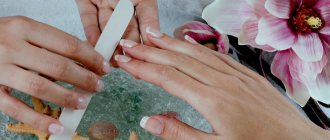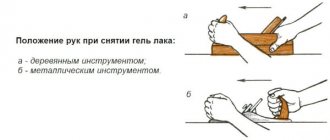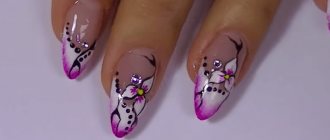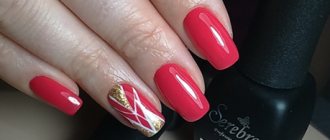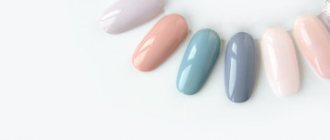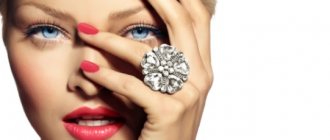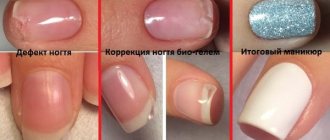Nowadays, every person wants to look attractive and beautiful. And beautiful nails are an integral part of an attractive look. The most popular today are two procedures: nail extensions and shellac. Despite the fact that these are quite different methods, many representatives of the fair sex cannot make a choice for a long time. Should I choose shellac or extensions? What are their features, advantages and disadvantages?
To answer these questions, you need to know exactly what the nail extension procedure and shellac are.
The nail extension procedure involves increasing the length of nails using a special gel or acrylic.
Shellac is a procedure during which the nails are simply covered with gel. Thus, the nail plate acquires greater strength and becomes stronger, healthier, and more attractive. It is worth noting that the length of the nail does not increase, it simply becomes stronger and more beautiful. An important advantage is that the nail polish lasts for a long time.
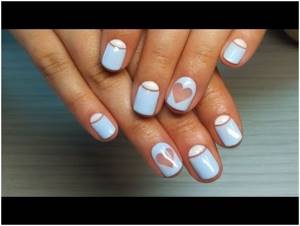
Description of shellac coating
What is the difference between shellac and gel polish and what kind of procedure is it? Let's figure it out. It is intended for those who love varnish manicure. At the same time, it places increased demands on it: it must dry instantly, not chip, be worn for a long time and not wear out.
Shellac is an excellent alternative to gel or acrylic; it strengthens the nail plate. It should be applied using a certain technology. This material is designed to cover natural nails.
Using shellac you can hide peeling, brittle and fragile nail plates. It lays on the nail as a weightless protective layer and provides it with mechanical protection. It has already been appreciated by young mothers who don’t have time to do a new manicure every three days, business women - they always need to look at their best, and chipped varnish will reveal their negligence.
On the video what is shellac nails:
Shellac does not spoil nails, does not fade or fade even with prolonged wear, and creates an excellent manicure appearance. The period of wearing it is 20 days on the arms and 6 weeks on the legs. Such indicators are due to the growth of the nail, so some girls need to repeat the procedure more often, and for others less often.
The material is easy to apply. If you already have a special UV lamp at home for drying nails, then you can safely buy such a varnish and conduct experiments.
Is it harmful to nails?
It consists of unique components that allow you to strengthen natural thin nails; the material creates a shock-absorbing layer, thanks to which the nail does not break even under mechanical stress, scratches and impacts. After proper drying, you should not wet your hands for an hour; when this time passes, the nail plates are no longer afraid of anything.
This material is odorless, so there will be no discomfort when working with it. Unlike conventional varnishes, it does not contain formaldehyde, dibutyl phthalate and toluene, therefore it does not harm the nail plate, and is also absolutely hypoallergenic. It is used according to the principle of ease of application and ideal durability. Drying shellac on nails occurs under an ultraviolet lamp, the same as for gel polish.
On the video - is shellac harmful for nails, reviews:
Contraindications
Are there any contraindications? It turns out that it is not the coating itself that affects the condition of the nails, but the procedure for removing it. If you do it at home incorrectly, you may encounter delamination and damage to the top layer. This is due to the use of acetone and other shellac removers.
They act aggressively on nails, but this is not excluded when using regular varnish. In addition, when using the latter, the solvent is used much more often, almost every three days, and when using shellac, you only need to remove it once every three weeks. If you approach the situation in this way, then your nails will only benefit from the procedure for applying the gel composition.
It turns out that the stronger the solvent, the more it damages the nails and also dries out the skin around them. Beauty salons take this fact into account, so they use special soft liquids enriched with medicinal plant extracts and fats. For example, ethyl acetate, the composition of which is similar to nourishing cream.
It contains oil components, beneficial vitamins B5 and E. Some products contain glycerin, which moisturizes the nails and makes them elastic . When choosing a remover in the form of acetone, you should try not to use it less than once a week, and soft liquids should be used no more than twice a week, but when using shellac, these restrictions are unnecessary, since it has to be removed no more than once every two weeks.
When removing shellac, you need to have a special stick, with the help of which the remaining coating is removed from the nail plate. You need to be careful with it, otherwise you can damage not only your nails, but also your skin, and then it will take a long time to restore them. For the first time, it is better to seek help from a specialist, and after the lesson learned, fix it yourself at home; in extreme cases, you can use a training video on removing shellac at home.
After the removal procedure and application of the next coating, it is advisable to take short breaks to allow the nails to recover, help them become stronger by rubbing mineral oils and plant extracts into them.
If we consider how the process of applying shellac affects the entire body, then we should not forget that a UV lamp is used to dry the material on the nails, which uses ultraviolet rays.
Why nails hurt after shellac is detailed in this article.
It’s also worth understanding how to quickly restore nails after shellac.
Why shellac doesn’t stick well to nails is detailed here: https://soinpeau.ru/spa/nogti/pochemu-shellak-ne-derzhitsya-na-nogtyax.html
But how to choose a lamp for shellac is detailed in this article.
Of course, you could wait for the varnish to dry naturally, but this would take a lot of time, and one layer dries in just one minute.
But during this time, the rays emanating from the lamp can provide a carcinogenic effect, so doctors advise to protect yourself and during the procedure of such a manicure use sunscreens or creams with at least a minimum degree of protection - SPF 15, and it is better to use drugs with a higher index.
Types of nail extensions
You can do extensions with acrylic or gel. It cannot be said that one type is better, because everyone chooses what suits him and his nails personally.
Acrylic extensions
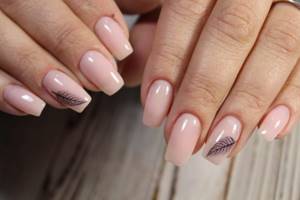
photo:

Acrylic extensions are done using a mixture of liquid and powder monomer. If the quality of the material is high, then there is a chance that the manicure will be as good as new within 3-4 weeks.
Advantages:
- Acrylic provides the perfect canvas for applying nail polish.
- The material does not need to be dried in a lamp.
- Acrylic nails are very strong.
- They last longer than gel ones.
- Easy removal.
- When you break an acrylic nail, you can fix it yourself at home (glue it with special glue and sand it with a file).
Flaws:
- Not cheap.
- High professionalism of the master is required.
- In the long run, acrylic actually weakens your nail.
- Exposure to chemicals on the respiratory system and a simply unpleasant odor (therefore, the room is often ventilated during the procedure).
Cautions:
Acrylic extensions are not as simple a procedure as it might seem. You and your nail technician need to know the safety rules (this is why you should only trust your nails to a qualified professional):
- Those who have skin diseases or nail problems should not apply acrylic nail extensions.
- If you feel unwell, stop the procedure immediately.
- Make sure that the manicurist's office is well ventilated or that a special hood is turned on.
- The technician must wear safety glasses and a disposable mask.
- Avoid contact of material with skin, eyes or mouth.
- Stop treatment if rash or redness appears.
- Find out from a specialist how to care for your nails and what to do if they break or become damaged.
Gel extensions

photo:
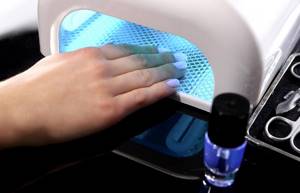
This type of extension is suitable for everyone, regardless of the length of their nails. The artist begins by applying a base layer, followed by a layer that constructs the nail. After each step, you must place your hand under the UV lamp and wait for a while. At the end, the master applies a glossy topcoat.
Advantages:
- Natural, glossy, well-groomed look.
- Lasts up to 14 days.
- The gel hardens faster than acrylic due to its drying in a UV lamp.
- More flexible than acrylic nails.
- Easy to remove.
- No chips.
- There is a smell, but it is not as rich as acrylic.
Flaws:
- Exposure to ultraviolet rays on the skin.
- Removing the gel can cause damage to your nails if the gel is used too often.
- It is more difficult to take care of your nails.
Safety when using gel extensions:
Like any other cosmetic procedure, this one also comes with risks. We recommend that you carefully approach the issue of choosing a good specialist, because only such a specialist knows how to properly and safely extend nails with gel. Moderation is also important here: take breaks to give your nails a break from the gel and stay healthy. And do not forget to follow all the instructions of the master. Provide your nails with the necessary care after the procedure according to the advice of a specialist.
What is the difference between acrylic and gel extensions?
Simply put, acrylic is a mixture of liquid and powder, while gel is a gel. If you want longer or stronger nails, you can choose one or the other. However, nails that have been extended with gel tend to be more flexible. They also cost about 15-20% more than acrylic.
How is it different from extensions?
Shellac combines the properties of regular varnish and gel. In the case of nail plate extensions, special trips, primers and forms are used, and shellac is applied to natural nails; it cannot be used to extend them. Instead of a primer, a degreaser or a regular dehydrator is used. During the process of applying shellac, the nail plate is not sanded and therefore is not injured.
The composition of the drug is perfectly fixed on it without this. When removing the coating, the top layer is not filed off, everything happens quite gently, a special product is applied to the nails; if the removal takes place in a salon, a liquid without acetone is used. The old layer is removed in 10 minutes.
Video: Shellac or Regular varnish
In the video, what is the difference between shellac and nail extensions:
When working with shellac, application does not cause any difficulties. The product is in a bottle similar to the packaging of regular nail polish; it is applied to the nail with the existing brush. The lack of a primer in the technology is compensated by a strong fixation base.
Shellac, after simple application, provides ideal durability, and can be quickly removed if necessary. But some people observe that after using it, the nail plate becomes drier than when using gel polish.
The process of nail extensions is designed to give them a new shape. The master performs a complex manicure, the result of which is elongated nails with a decorative coating, and shellac is applied only to the length of the natural nail. You can paint multi-colored patterns on gel polish, while Shellac provides a maximum combination of only two colors.
It is impossible to unequivocally answer the question of whether nail extensions or shellac coating is better, since you need to consider a specific case. Based on the duration of the procedure, the gel polish is applied and lasts longer, provided that the best gel for nail extension is used.
In the photo - shellac nails:

It can only be removed in the salon, while its analogue can be removed independently, just prepare a cotton swab, nail polish remover and foil. This type of nail decoration is perfect for girls who have a thin nail plate, and they cannot afford to make it even smaller by sanding the top layer.
But shellac is not suitable for those girls who constantly type on the keyboard, since its layer will quickly crumble, and also if their hands are often in the water, for example, swimmers or dishwashers. Those who love long nails will have to wait until they grow to the desired length, otherwise they would be better off opting for gel polish.
Why shellac is better
Shellac has many advantages:
- Natural appearance. The demonstrated shellac nail extension in the photo below allows you to verify this. The gel material easily camouflages existing grooves; the varnish needs to be renewed very rarely.
- There is no need to file your nails. When applying shellac, correction or removal of a layer does not cause any unpleasant sensations in a woman. It is known that in order to completely remove the plate, the master has to treat the surface of the plate with a nail file.
- Shellac is suitable for women who believe that there is nothing better than short, well-groomed nails. In the photo you can see how organic the material looks.
- Gel polish is a great option for those who do a lot of housework. If the step-by-step instructions are strictly followed, the surface will be durable and resistant to detergents.
Combining shellac and extensions is not recommended. The video demonstrates all the negative sides of combining the two procedures. Which one to choose is up to the woman.
How much does the procedure cost?
The prices for such coverage vary widely, depending on the region in which you live. They are also influenced by the quality of the material and tools used, because you can buy cheap raw materials. The UV lamp, the product itself and the fixative for it can be found on numerous Chinese wholesale sites.
The price of the issue will depend on where the procedure is performed; if you decide to perform it at home, then you need to take into account that initially you need to purchase a starter kit of everything you need, its price on average is 5,000 rubles. But you can buy everything gradually. But then you won’t have to spend money every month on an expensive procedure in the salon.
Salon prices for shellac coating range from 1000-1500 rubles, and its price with removal of the previous coating reaches 2000 rubles.
The entire process of using shellac is accompanied by pleasant sensations. After completing the procedure, the master applies softening oil to the cuticle, preventing it from drying out, and then massages the hands with a nourishing cream to remove the drying effect of the ultraviolet lamp rays. Shellac can not only decorate nails, but also make them stronger, eliminate their fragility and accelerate growth. After this procedure, you no longer need to worry about accidental scratches and chips; shellac will prevent them from appearing on its surface.
But why you need a primer for shellac can be understood if you read the contents of this article.
It’s also worth understanding what you need for shellac at home.
But why you need a primer for gel polish is detailed in the contents of this article.
It’s also worth understanding which primer is best for gel polish, which is described in detail in this article.
You may also be interested in learning about how to coat your nails to make the polish last longer.
CHARACTERISTICS OF BIO GEL AND SHELLAC
Biogel prevents nail splitting. The coating must be changed every 2-3 weeks, just like shellac, while they “breathe” and grow.
Shellac is durable, impact-resistant, and retains its color and shine throughout its wear. For 2-3 weeks you will not have to think about a manicure, since there will be no scratches or chips on the coating.
The advantage of shellac over biogel is that the latter interacts poorly with acetone and alcohol products. When using them, you must protect your hands with gloves.
Shellac has an excellent color palette and can be applied to all kinds of designs. There are hundreds of thousands of manicure options using shellac: French, moon manicure, reverse French, gradient and many others.
Unlike shellac, biogel not only creates an excellent coating, but also makes it possible to strengthen and extend nails. In this case, as mentioned above, the shade can be selected as close as possible to the natural color, or it can be colored. French treatments using biogel are very popular. You can choose the colors, shape and length of the nail yourself.
Reviews
- Polina, 31 years old: “With my rhythm of life, Shellac is irreplaceable. With him in my arms I feel like a real woman. We girls know how important a manicure is to those around us. When communicating, I often gesture with my hands, imagining what my partners would think of me if I were without a manicure. Sometimes in a series of events I forget to come to the next coating session, but my master constantly reminds me of this, which is very convenient. I go to her once every three weeks, that’s how long my nails are in perfect condition.”
- Rimma, 46 years old: “I did Shellac coating several times. I’ll say right away that its quality will depend on the experience of the master. The first time it literally fell off in pieces on the third day. And I decided to return to gel polish, until a friend introduced me to her trusted master, who is also a virtuoso in his field, after she covered my nails with shellac, I had a wonderful manicure for a whole month.”
general information
Shellac is a CND product released in 2010. Almost instantly he gained universal popularity, and by the end of the year he received several prestigious awards. This is a unique product, a symbiosis of nail polish and modeling gel. Later, other manufacturers picked up the idea, but no one succeeded in completely repeating the original.

Gel polish is a modeling gel that is easy to apply, washes off quickly, and does not dry in the air. It is not a CND product.
How to save money on manicure?
Do you want to perfectly master the art of manicure from A to Z and never spend 2,000-3,000 rubles in a salon again? Then learn how to do a manicure yourself and save money, time and nerves!
Come to our School for an online course from top teacher Tatyana Svoboda “Manicure for yourself,” which can now be completed for only 499 rubles !
The teacher will tell you all about the technique of applying the coating, removing it, modern designs, how to strengthen your nails, and much more. You will become a real pro and will be able to create your dream nail designs, and, if you wish, monetize your hobby in the future!
Course bonuses:
We give all students a 15% discount on ready-made manicure starter kits, as well as a 5% discount on purchases at ParisNail and 15% on any other online course. Upon completion of the training, you will be issued an electronic certificate of completion of the course.
What are acrylic nails?
Acrylic nails are made using a mixture of liquid and powder monomer that is rolled into a ball of dough-like material, brushed onto the nails, and air dried. When you get acrylic nails done, the specialist usually tries to give them a natural shape, although no one can cancel the flight of fancy. After this, each nail is shaped and painted with varnish. If you want more length or change the shape of your nails, acrylic is perfect for you.
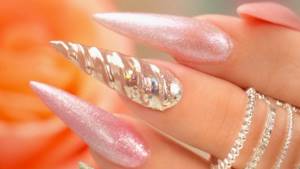
Acrylic nails last about two weeks with proper care. Nail correction performed with a special device can extend their life by several weeks.
Advantages of the coating: durable, varied choice of lengths and shapes.
Cons: frequent correction for a neat look of nails, smell of chemicals during the procedure, acrylic can damage your nail. Plus it's very expensive.
What is gel polish?
Coating your nails with gel polish promises you a glossy manicure for two weeks. If your nails are pretty good and you just want to give them a neater look, then you should opt for this particular coating. The procedure is no different from applying regular varnish; it just uses a special ultraviolet lamp for drying.
Advantages of the coating: shiny and glossy finish, no damage to the nail plate, no chemical odor, long-lasting effect and fast drying time.
Cons: negative effects of ultraviolet rays.
Application technology
In order for a manicure to live up to expectations, it is necessary to adhere to a strict sequence. Firstly, the biogel is first applied according to all the rules and canons of nail strengthening. The procedure is carried out from start to finish, with the exception of the last step - applying the finishing layer. It is not required if the top of the nails will be covered with gel polish. Secondly, before applying Shellac there is no need to make a substrate (the first preparatory layer, the base). This role is already performed by biogel. Thirdly, shellac is applied using conventional technology and secured with a final protective coating. There shouldn't be any changes here.
If you adhere to the correct technology for applying one material to another, then they will not reject each other. A properly applied coating will not chip and your nails will not look too compacted. It is also noteworthy that Shellac applied to biogel does not in any way affect the basic properties of the latter. The material will not interfere with air circulation, as well as the influx of beneficial vitamins from the outside (for example, from strengthening nail baths, which can be done even when the nails are covered with biogel).
